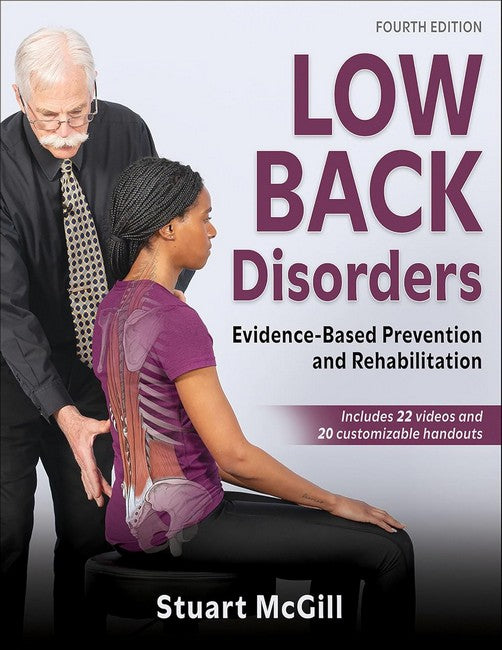Stuart McGill, PhD, is a distinguished professor emeritus at the University of Waterloo in Ontario, Canada, and chief scientific officer at Backfitpro Inc. He is a world-renowned lecturer and expert in spine function, injury prevention, and rehabilitation. He has received several awards for his work, including the Volvo Bioengineering Award for Low Back Pain Research from Sweden and the Order of Canada for contributions to back pain assessment and treatment. McGill previously served as the president of the Canadian Society for Biomechanics and as an elected member of the executive for the International Society of Biomechanics. He sat on the editorial boards of the journals Spine, Clinical Biomechanics, and Journal of Applied Biomechanics. McGill has produced over 245 scientific publications on lumbar function, mechanisms of low back injury, investigation of rehabilitation programs matched to specific categories of back pain patients, and the formulation of strategies to avoid work-related injuries. He has provided expertise to government agencies, corporations, professional athletes and teams, and legal firms. He is one of the few scientists who, in addition to performing research, is regularly requested by those in the medical profession and by sports teams to consult on challenging patients from around the world.
Request Academic Copy
Please copy the ISBN for submitting review copy form
Description
Part I. Scientific Foundation Chapter 1. Introduction to the Issues and Scientific Approach Unique to This Book Legislative Landscape: The Unfortunate Adverse Impact on Painful Backs Deficiencies in Current Diagnostic Practices Inadequacies in Current Care and Prevention Mechanical Loading and the Process of Injury: A Low Back Tissue Injury Primer Excellent Clinicians and Excellent Practice Unique Scientific Foundation of This Book In Vitro Lab In Vivo Lab A Final Note Chapter 2. Epidemiological Studies and What They Really Mean Influence of Randomized Controlled Trials and Other Epidemiological Approaches Misunderstandings of Epidemiology Multidimensional Links Among Biomechanical, Psychosocial, and Personal Variables How Do Biomechanical Factors Affect LBD? Links Between Personal Factors and LBD Studies of Exercise Intervention Practical Application: What the Evidence Supports What Works Clinically A Final Note Chapter 3. Functional Anatomy of the Lumbar Spine Anatomy Trains Fascia: How Our Understanding Has Changed and Its Large Influence on Biomechanics, Resilience, and Performance Basic Neural Structure Vascular Anatomy Vertebrae Sacroiliac Joints Intervertebral Disc Muscles Ligaments Lumbodorsal Fascia (LDF) Quick Review of the Pelvis, Hips, and Related Musculature Clinically Relevant Aspects of Pain and Anatomic Structure A Final Note Chapter 4. Normal and Injury Mechanics of the Lumbar Spine Kinematic Properties of the Thoracolumbar Spine Kinetics and Normal Lumbar Spine Mechanics Dubious Lifting Mechanisms Other Important Mechanisms of Normal Spine Mechanics Injury Mechanisms Biomechanical and Physiological Changes Following Injury A Final Note Chapter 5. Myths and Realities of Lumbar Spine Stability Why Spine Stability Is Important for Everyone Stability: A Qualitative Analogy Quantitative Foundation of Stability Stability Myths, Facts, and Clinical Implications A Final Note Part II. Injury Prevention Chapter 6. LBD Risk Assessment Brief Review of the Risk Factors for LBD NIOSH Approach to Risk Assessment Snook Psychophysical Approach Lumbar Motion Monitor (LMM) Ergowatch Approach Biological Signal-Driven Model Approaches A Final Note Chapter 7. Reducing the Risk of Low Back Injury Lessons From the Literature LBD Prevention for Workers The Question of Back Belts LBD Prevention for Employers Injury Prevention Primer A Note for Consultants Reducing the Risk in Athletes A Final Note Part III. Low Back Rehabilitation Chapter 8. Building Better Rehabilitation Programs for Low Back Injuries Pain-Reducing Mechanisms of Exercise Five-Stage Back Training Program Finding the Best Approach Stages of Patient Progression Guidelines for Developing the Best Exercise Regimen A Final Note Chapter 9. Evaluating the Patient Most Crucial Element in Evaluation First Clinician-Patient Meeting Assessing Posture and Movement Quality Some Provocation Tests Some Functional Screens Testing Muscle Endurance A Final Note Chapter 10. Developing the Exercise Program Philosophy of Low Back Exercise Design Clinical Wisdom Thoughts on Mobility Identifying Safe and Effective Exercises Beginner's Program for Pain Control and Stabilization Exercises That May Be Used in a Stabilization Program Special Conditions A Final Note Chapter 11. Advanced Exercises: Preparing for a More Robust Life Safely Increasing Challenges Occupational and Athletic Work Hardening A Final Note Epilogue Appendix Glossary References and Additional Readings Index About the Author

